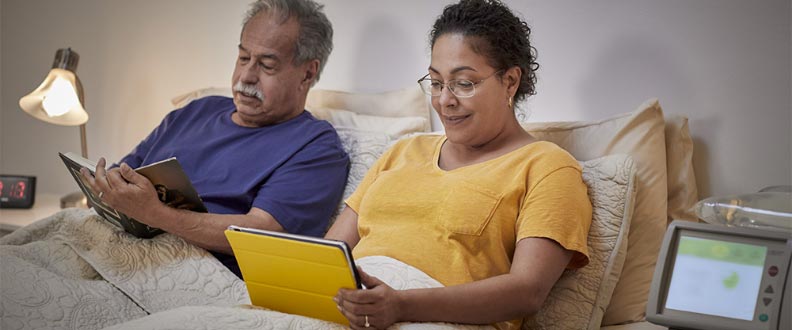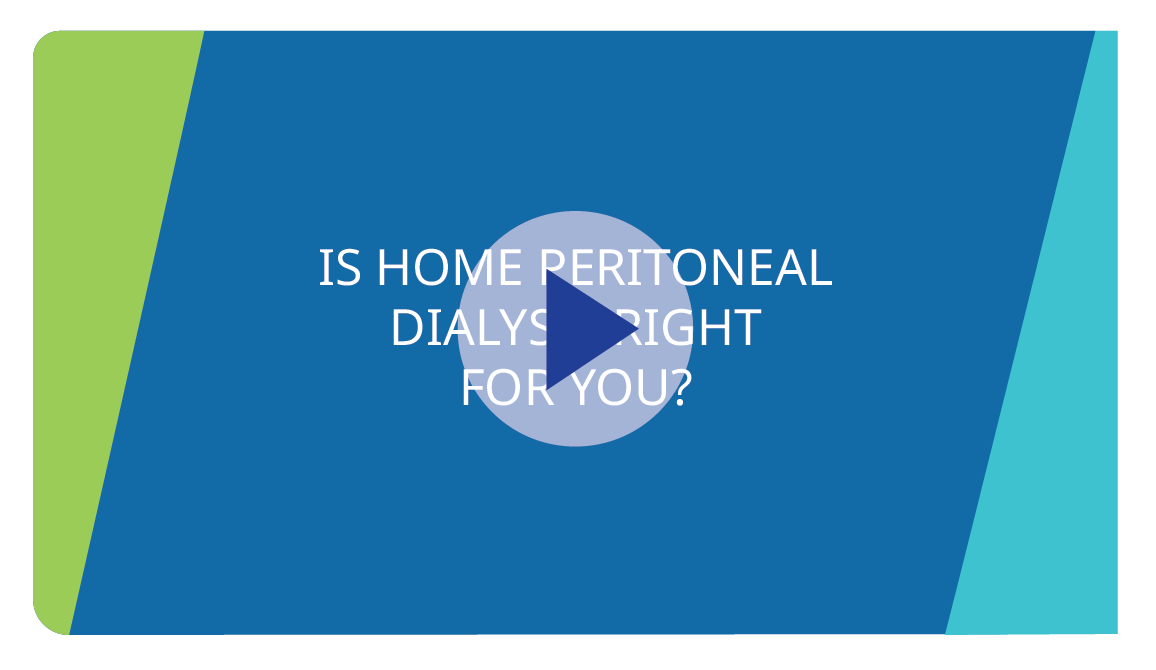
What Is Peritoneal Dialysis?
PD is typically done at home or in any other clean, enclosed environment. PD treatments are done more frequently, so waste and toxins in your blood don’t have a chance to build up as much between treatments. Home peritoneal dialysis may also mean fewer food restrictions and less medication, which makes PD a great way to start your home dialysis journey.
How does peritoneal dialysis work?
Are there different types of peritoneal dialysis?
There are 2 types of peritoneal dialysis: continuous ambulatory peritoneal dialysis (CAPD) and automated peritoneal dialysis (APD). Both types of peritoneal dialysis have the same basic function, but each have their own methods and advantages to consider.
Continuous ambulatory peritoneal dialysis is done without a machine, and requires 3 to 5 exchanges per day. You perform exchanges manually in a clean, well-lit place. Each exchange takes 30 to 40 minutes. The benefit to CAPD is that it allows you to manage your dialysis from home, work, or while traveling.
Automated peritoneal dialysis, also known as continuous cycling peritoneal dialysis (CCPD), uses a machine called a cycler to perform each exchange. CCPD can be done as one long session on the cycler while you sleep or in multiple shorter sessions, using the cycler just to drain and fill throughout the day.



What are the benefits of peritoneal dialysis?
- Independence
You can do peritoneal dialysis (PD) at home while still having regular monitoring and phone access to a 24/7 on-call PD nurse. - Flexibility
You can make your own schedule and do PD almost anywhere—at work, at home, and while traveling. All you need is a space that is well lit, clean, and indoors. - Preserve kidney function
If started early, PD may help preserve your remaining kidney function. Because it supplements your kidney function rather than replaces it, you may also require less treatment time. - Natural treatments
PD treatments are usually painless and may involve fewer dialysis medications. - No traveling to appointments
You will have more free time without the hassle of traveling to and from the center for dialysis treatment. - More freedom
You will have more freedom to work and be social thanks to a more flexible schedule. You can even do PD while you sleep. - Gentler on your body
PD is considered to be easier on your body, including your heart. You may experience fewer side effects than with other forms of dialysis.

Home PD is closest to natural kidney function. Find out if it may be a good option for you.
Factors to consider with home peritoneal dialysis
- A peritoneal catheter (a soft, flexible tube) will be surgically placed in your abdomen.
- Typically, PD catheter surgery is a minor operation that takes less than one hour. You will likely be placed under local anesthesia and go home the same day.
- After your PD catheter is placed, you will need to avoid swimming, bathing, or showering for 1-2 weeks, or according to your care team’s instructions. This is to protect the dressings from the operation during recovery, as they are not waterproof. You may use a washcloth or sponge to clean your body, while ensuring your PD catheter access site remains dry.
- You’ll receive detailed training at your center to ensure you feel comfortable doing PD on your own. You’ll also learn proper PD catheter care.
- Following certain precautions will help you avoid the risk of an infection called peritonitis. Your nurse will give you instructions on how to avoid infection.
- You will need ample storage space for your supplies.
- If you have diabetes, know that your doctor may need to adjust your diabetes medications. That’s because the dextrose, the type of sugar in the dialysis fluid, may make your blood sugar levels higher and cause weight gain.
- You should expect to do treatments every day, 7 days a week—as prescribed by your nephrologist.
- You will visit your center once or twice a month for laboratory testing and check-ins with your doctor and care team.

Time needed to do peritoneal dialysis
The time needed to do peritoneal dialysis may depend on the type of PD you choose. For instance, since CAPD is continuous, you’ll need to give yourself time for your treatment (draining or filling) throughout the day. In the peritoneal dialysis procedure, draining takes about 15-20 minutes; filling takes about 10 minutes.
If you choose APD (CCPD), the type of PD that uses a cycler machine, and you choose to do treatments at night while you sleep, you’ll only spend about 3 hours a week prepping and cleaning your supplies. Your care team will be able to provide you with more details about how much time it will take for your peritoneal dialysis treatmentPeritoneal dialysis complications to know about
- Infection
There’s a possibility of infection inside your peritoneum while on peritoneal dialysis—a condition known as peritonitis. You could also develop an infection around your access site, where the catheter is inserted. Proper hygiene and access site care can help avoid infection. - High blood sugar
If you have diabetes, the dextrose (a type of sugar) found in some types of dialysate may cause your blood sugar levels to go up. Talk to your doctor about whether you’d need to make any adjustments to your diabetes care when doing PD. - Weight gain
The dialysate solution used during peritoneal dialysis contains dextrose—a type of sugar—which may cause your body to take in extra calories throughout the day, leading to weight gain. - Hernia
After your PD access surgery, it’s important to avoid lifting anything heavy, climbing stairs, or straining your abdominal muscles for at least 6 weeks or as recommended by your doctor to lower the possibility of developing a hernia. - Catheter complications
Blockages or malfunctions in your PD catheter may result in delays or changes to your dialysis treatment plan. - Ineffective dialysis
Over time, peritoneal dialysis may not work as well and your doctor may recommend that you switch to hemodialysis.

